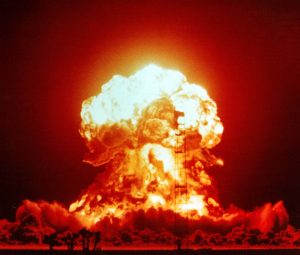A few security and defense links to kick off the weekend:
Nukes of Hazard takes a look at a report published by the Physicians for Social Responsibility that aims to determine the local and global impact of a limited nuclear war in South Asia. In the study, the author envisioned “this ‘limited’ war to be one in which a total of 100 15 kiloton nuclear weapons would be detonated (less than 0.1% of the current global nuclear arsenal). Using conservative estimations, these 100 nuclear explosions would release 5 million metric tons of black carbon aerosol particles into the earth’s upper atmosphere.”
If that sounds bad, that’s because it is. The speculative report suggests, among other outcomes, a devastating famine cause by falling crop yields, a drop in global surface temperatures, a surge in global food prices, and an international disease pandemic precipitated by all the above. The report really hits home the terrifying threat posed by even a regionally-limited nuclear war with low-yield weapons.
In another thought-provoking post on nuclear weapons, Alex Wellerstein over at Restricted Data asks the provocative question: are nuclear explosions art? I’ll let readers come to their own conclusions on that one.
North Korea could be back at the top of East Asia’s potential flashpoints (displacing the much-discussed East China Sea ADIZ) after Kim Jong-Un’s decision to purge and execute his somewhat reformist uncle, the de facto regime number two, on Thursday. My colleague Zachary Keck argues that the manner of Jang’s purge reflects Kim’s “acute insecurity.” Shannon Tiezzi explores the potential impact the purge could have China-North Korea relations.
The United States military, in a show of technological acumen, successfully downed incoming mortar rounds and drones from a vehicle-mounted laser system, according to Agence France-Presse. The weapon system, the High Energy Laser Mobile Demonstrator (HEL MD), won’t be operational until 2022 but the tests reinforce the great promise in laser technology and its potential to transform the future of anti-air and defense technology.
While the United States showed off the cutting edge of its military technology, India put to rest an old and faithful servant: the MiG-21FL. The MiG-21FL was once a matter of pride for the Indian Air Force, which found itself in the “supersonic era” by procuring the aircraft from Russia a couple generations ago. The jet’s reliability and versatility made it an important reference point in the development of India’s air doctrine. It remained a tactical first choice for Indian commanders as recently as the high-altitude Kargil War in 1999.
South Korea won a $1.1 billion deal in Iraq to sell its multi-role T-50IQ supersonic aircraft. Iraq will purchase 24 of the multi-role light fighters to build up its air force.
Singapore’s defense minister said that the nation has no imminent plans to purchase any F-35 Joint Strike Fighters from the United States.
U.S. Congressman Randy Forbes (R-VA) and the American Enterprise Institute’s Michael Auslin argued in the Wall Street Journal that the American response to China’s Air Defense Identification Zone (ADIZ) over the East China Sea was unsatisfactorily reassuring to American allies in the region.

































